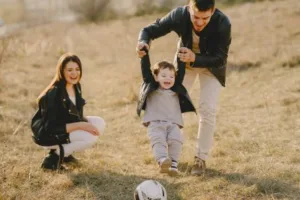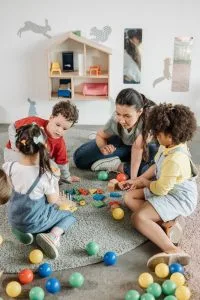 Much emphasis is placed on the value of reading to children and finding creative ways to help them memorize the alphabet and numbers — and with good reason. This type of cognitive development helps improve a child’s language skills and fuels their imagination, but it does not engage all of a child’s senses.
Much emphasis is placed on the value of reading to children and finding creative ways to help them memorize the alphabet and numbers — and with good reason. This type of cognitive development helps improve a child’s language skills and fuels their imagination, but it does not engage all of a child’s senses.
Parents and educators are still learning about the importance of sensory activities for preschoolers. Sensory play can be as simple as riding a tricycle or squishing slime between their fingers. Children naturally enjoy sensory activities if they are given the tools needed to explore this type of play.
In this article, we’ll discuss the importance of sensory play for toddlers and provide a list of activities both you and your child will love.
What Are Sensory Activities for Toddlers?
Babies and toddlers are natural explorers — almost every waking moment is spent discovering how everything in their world feels, tastes, and sounds. They don’t have to be consciously introduced to sensory play, but providing them with interesting and new activities to enjoy will encourage their natural curiosity.
As the term implies, sensory play stimulates a child’s senses. Any activity that accomplishes that goal is technically a sensory activity. However, most planned sensory activities focus on sight, touch, and hearing because these senses are the easiest to access. Some activities may also incorporate smell and taste.
Sensory activities encourage children to explore the world through their senses. Experiencing how different objects feel or sound expands their understanding of how they work and how to interact with them.
The Benefits of Sensory Play for Toddlers
Sensory activities for kids engage two often-overlooked sensory systems: the vestibular and proprioceptive systems.
Your vestibular system is responsible for maintaining your balance while you engage in other activities. Your proprioceptive system helps you manipulate your body in space. It tells you how much force is needed to hold, push, lift, or pull an item, and it also makes you aware of where the parts of your body are in relation to one another.
Along with developing these systems, other benefits of sensory games for toddlers include:
- Improved language skills
- Improved motor skills
- Better cognitive development and problem-solving abilities
- Calming and stress-relieving effects
- Opportunities for social interaction
- Opportunities for self-play
Engaging in sensory play helps build nerve connections in a young child’s brain pathways, which can help them complete more complex tasks as they get older. Sensory activities are recommended for children from infancy into early childhood.
20 Sensory Activities for Toddlers
All forms of play are sensory, but sometimes parents, educators, and toddlers need planned activities. The key to thinking up sensory ideas for toddlers and other young children is to have fun! If an activity isn’t fun, it won’t keep a toddler’s attention for very long.
Here are a few ideas for toddler sensory activities to get you started.
 1. Sensory Bin
1. Sensory Bin
A sensory bin is simply a storage container filled with a variety of objects with interesting shapes and textures. Toddlers love pulling things out of drawers, and pulling items from a sensory bin is just as exciting.
To make a sensory bin, place small items like cotton balls, beans, yarn, pom-poms, sand, and rice into zipping storage bags. Reinforce the bags with packaging tape to prevent them from opening. You can also include larger items like squishy balls, fidget toys, and blocks if you’d like. Change the sensory toys occasionally to keep your child interested.
2. Swinging
Playing on a traditional playground swing is a classic sensory experience, and you can provide new ways to enjoy this activity even if you don’t have room for a swing set in the backyard. With the help of parents or older children, toddlers can be swung in a blanket or enjoy a spider web–style tree swing outside.
3. Rocking
Chances are you’ve rocked your baby a million times, but just because they’re older doesn’t mean they shouldn’t still engage in this sensory motion. Rocking is another movement that is natural for young children. Rocking chairs, rocking horses, and other rocking toys provide hours of fun and sensory play.
4. Playing Dress-Up
This one is fun for everyone in the family! Keep a stash of scarves, hats, and fabric scraps handy for this sensory activity. Choose items with lots of different textures like velvet, faux fur, or corduroy to increase the sensory appeal.
5. Spice Cabinet
If you’re looking for sensory activities for 3-year-olds and up, try playing Spice Cabinet. Younger children may not yet be able to grasp the idea of taking small sniffs, so this one is best reserved for older children. With supervision, let the child smell a variety of herbs and spices and allow them to respond without prompting.
6. Guess What?
Cut two holes in the side of a storage bin that are large enough for children to place their hands in. Hide a toy or other object in the box and secure the lid. Let kids take turns guessing what the item is just by feeling it.
7. Kick a Ball
This may seem like a standard backyard game, it’s another natural play activity that is actually a learning experience. Kicking a ball back and forth helps toddlers improve their coordination and work their gross motor skills.
8. Playing with Bubble Wrap
Who doesn’t love popping bubble wrap? Playing with bubble wrap is one of the easiest sensory activities for 2-year-olds and younger children because it requires little to no direction (just your supervision). Walking and jumping on bubble wrap with bare feet increases the sensory experience.
9. Splash and Play
Most children are fascinated with water. If your child enjoys getting wet, set up a baby pool or large storage container outdoors with cups, spoons, balls, and other items they can use to splash and pour.
10. Make Modeling Dough
Playing with playdough is a part of almost every child’s memories, and it’s also a fantastic sensory activity. You can buy playdough, but making your own adds to the fun. There are several versions of homemade playdough recipes available on the internet.
11. Bake Bread
Any type of cooking or baking is an opportunity for sensory learning. Bread baking is one of the best sensory activities for toddlers who enjoy using their sense of smell. Let younger children measure ingredients, knead and punch down dough, and help form it into different shapes for baking. The smell of baking bread — and the pleasure of eating it — helps reinforce the experience.
12. Playing Music
Keep a supply of kid-friendly musical instruments handy for impromptu sensory jam sessions. You could also help kids make their own instruments from household objects. For example, put some dried beans in an empty margarine tub to make an interesting drum/shaker combo.
13. Hear It, Guess It
Have your toddler hide their eyes while you place an object behind your back. Choose an item that makes a distinguishable noise, like a toy with a bell or a crinkly piece of paper. Ask your child to guess what the object is just from the noise it makes.
14. Mud Pies
Playing in the mud is a classic sensory experience that many kids today miss out on. Set aside a collection of unbreakable spoons, cups, and pie plates to make your kids an outdoor “mud kitchen.”
15. Sorting
Mix several colors and sizes of yarn pom-poms together and let kids sort them into different containers. To make this activity even more challenging, have them use a pair of plastic tweezers or tongs to pick up the pom-poms. Different shapes and colors of pasta also work for this activity.
16. Beading
All the different colors, sizes, and textures of beads make this activity a natural fit for sensory play. Instead of beading wire or string, give younger children stiff pipe cleaners and large-holed beads so they can work independently.
17. No-Mess Painting
This sensory game is mess-free but fun. Place a piece of white paper and a few squirts of craft paint in a large plastic storage bag and seal the top securely. Let your child poke, push, and squish the paint around without getting their hands dirty. Take the new masterpiece out of the bag so it can dry if you want to keep it.
18. Taste Test
This type of sensory play for toddlers helps expand a picky eater’s repertoire. Let them taste a variety of foods they enjoy while wearing a blindfold and see if they can guess the food. Sticking with foods they already know and like will keep the game enjoyable and reinforce the idea that trying foods is fun.
19. Sensory Bottles
Add some water, oil, glitter, sequins, small beads, and a few drops of food coloring into a clear water bottle. Seal it by using a hot glue gun to secure the top. Let your toddler shake, swirl, and turn the bottle to see all the changing colors and textures. To enhance this activity, you can play a game by asking your toddler to find items in the bottle by color, shape, or size.
20. Jump and Crawl
Lay all of your pillows, couch cushions, and chair cushions on the floor to create a safe place for toddlers to jump and crawl around. The more different textures you can include, the better. Make sure to clear out any sharp objects or heavy furniture from the space beforehand.
Hire the Experts on Sensory Activities for Toddlers
Making sensory activities a regular part of your toddler’s playtime offers a number of benefits. Sensory play not only keeps active children busy and focused on a task, but it also helps them improve their fine and gross motor skills while developing better communication skills. However, not all parents have the time or natural creativity to plan sensory activities.
Au pairs are trained childcare professionals with experience in helping children develop their cognitive skills. Even families who don’t need full-time childcare services can benefit from including an au pair in their child’s development team.
If you’re ready to hire a professional to help in your child’s development, find an au pair today!



 1. Sensory Bin
1. Sensory Bin